Another year, another fantastic year of comics. And, another year where comic book characters demonstrated their dominance in pop entertainment.
You know it’s a big year when some of 2014’s top-grossing movies (Captain America: The Winter Soldier, Guardians of the Galaxy, X-Men: Days Of Future Past) and some of the most-watched (The Walking Dead, Arrow), and well-liked (Flash) — if not exactly critical darling (ahem, Gotham, Constantine) — TV shows are coming from comics. And there’s a steady diet rolling out in the year to come, for better and worse. And really, you know it’s a big year when non-comic-reading pals ask me about developments on S.H.I.E.L.D. or tell me about how much they love talking raccoons — or at least, Chris Pratt dancing to Redbone songs. To me, that means comics are in the mainstream in a way I never imagined they would be growing up. And if the Marvel movies did anything, to me it showed that comics don’t have to be 100 percent superheroes; they demonstrated they can come from any genre — be it a ’70s paranoid espionage thriller, or sci fi and fantasy, or swaggering comedy and space adventure.
If you’re at all curious to try comics, now’s the time. It’s never been easier to find a story that appeals to you, whether you want superheroes or something different. And if you don’t have a comic book store, there’s nothing more convenient than downloading a comic or a graphic novel on the iPad or tablet, or just going to a regular bookstore and find collected editions.
For this list, I decided to do something different than simply churning out top ten of the best comics. First, I either ignore or don’t have time for lots of comics, so that list would be incomplete at best. Second, that list would include a lot of the same stuff as years past — Saga, Daredevil, Fatale, The Private Eye, Mind MGMT. All continued to be superb in 2014, either hitting their stride, ratcheting up the tension, or perfectly landing its finale. What more can you say beyond “Yup, still great!”?
Instead, I’d rather focus on new stuff I fell in love with in 2014. That’s more fun. So let’s dig in.

MS. MARVEL
Writer: G. Willow Wilson | Artists: Adrian Alphona, Ian Herring, Jake Wyatt, Jamie McKelvie | (Marvel)
It’s easy to forget, but only a few years back, things looked pretty grim for female protagonists in comics, and especially at Marvel. Maybe Marvel doesn’t have its own Wonder Woman — a character as ubiquitous as Superman or Batman or Spider-man, where everyone knows that name whether they read comics or not. But arguably, they’ve got a deeper bench of fascinating women heroes who, in the right hands, could be huge.
But lately, Marvel’s editorial team has made some legit strides towards diversity, both in female and minority characters — though admittedly more slowly with diversity with creators. Now look around: Captain Marvel (a.k.a. Carol Danvers) is about to have her own blockbuster film thanks to writer Kelly Sue DeConnick’s exceptional take on the character — and because of the most loyal fanbase around. And the Marvel Now initiatives soon brought out a whole slew of fantastic solo books — best among them, Black Widow (by Nathan Edmondson and Phil Noto); Elektra (by Haden Blackman and Michael Del Mundo); and She-Hulk (see below). While there’s still more to do to improve — especially when it comes to developing more diversity among creators — it’s a noble start, and one that doesn’t feel like a gimmick or temporary: Marvel is now showcasing its widest array of female superheroes yet — with something for everyone.
Front and center of this is Kamala Khan, a brand new teenage character who takes up the moniker Ms. Marvel once held by Carol Danvers. Written by G. Willow Wilson and drawn by Runaways illustrator Adrian Alphona, Ms. Marvel is, hands down, the best new superhero series of the year, and culturally important because the character is a Pakistani American. A lot has been discussed in the media about Kamala being a Muslim superhero, and there’s no denying that’s a big deal. It’s great that Muslim readers can finally be able to see something of themselves represented in comics, and for other readers, it is a chance to glimpse into a culture rarely portrayed with such finesse and care in pop culture.
But from issue one, Ms. Marvel has been one of the most fully realized debuts I’ve ever read. Wilson’s script and Alphona’s quirky pencils immediately ease you into Kamala’s life with the kind of tiny and specific details that reveal delightful insight into personality. Living in Jersey City, New Jersey, Kamala has an origin a lot like Peter Parker: She’s a normal geeky kid — one with a love for the Avengers just across the Hudson River — who must juggle schoolwork and the pressures and expectations of her more conservatively religious parents, from whom she has to keep her social life a secret. This is a character that’s full of layers: She’s funny and shy, a little weird, and has a lot of heart. It’s easy to root for her to get a win.
And that’s before she even encounters a mysterious cloud (ahem, the Inhumans’ Terrigen Mists) that wafts over from Manhattan. When she pops out of her goopy cocoon, Kamala discovers her newfound powers to shapeshift — a clever way to personify the feeling of wanting to blend in with the cool kids as a teenager, being a Muslim in the U.S., and as a superhero who must protect a secret identity. Beyond Kamala, it’s remarkable that every major character has just as much complexity and depth.
Like its spiritual forebear, Brian K. Vaughan and Alphona’s The Runaways, Ms. Marvel proudly wears its ties to the mainstream Marvel Universe on its sleeve, yet remains standalone enough and of a singular artistic vision to be the perfect gateway superhero comic for those wary of jumping into full-blown crossover mode. It’s no wonder this new Ms. Marvel has become a best-selling, critically-acclaimed, cosplaying and fan-art phenomenon: Even removed from the larger cultural relevance, this is just great storytelling.
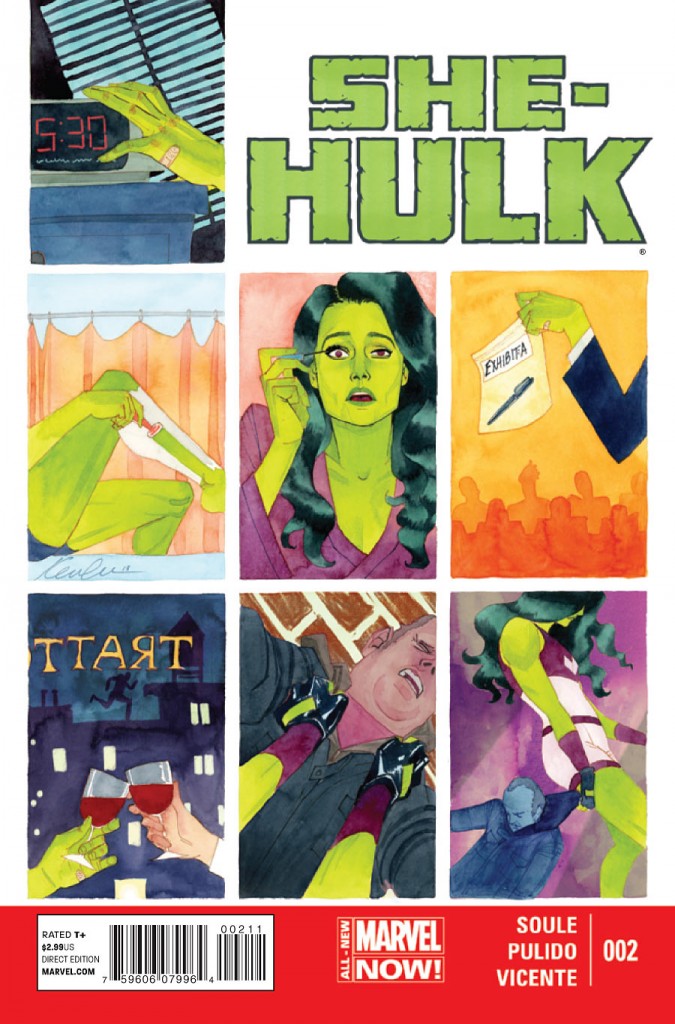
SHE-HULK
Writer: Charles Soule | Artists: Javier Pulido, Ronald Wimberly, Musta Vicente, Kevin Wada | (Marvel)
In comics, there are some protagonists that have far more interesting day jobs than their lives as superheroes. As much as I enjoy Daredevil’s ongoing crime drama, I always found Matt Murdock’s work as a lawyer fascinating — especially when his cases and clients overlapped into that world. That’s especially true of She-Hulk, too. Despite acclaimed runs by John Byrne, and later, Dan Slott, I never truly understood the appeal of the character (on the surface, a legacy hero spinoff) until Charles Soule took the reins this year.
Where Ms. Marvel represents a coming of age story about a teen figuring things out, She-Hulk is a confident powerhouse hero more at ease with what she’s already become: Jennifer Walters (Bruce Banner’s cousin), is a better lawyer than she is a superhero — equally capable of fighting toe-to-toe with any monstrous villain as going head-to-head with anyone in the courthouse, even Murdock himself. In Soule’s hands, Walters is a whipsmart lawyer with a high pedigree of legal ethics, and stylish yet quirky and witty woman with plenty of pathos — particularly when she decides to leave her high-paying firm to start her own struggling firm in Brooklyn. And the way that Soule, a lawyer in real life, infuses his stories and dialogue with a deep knowledge of the legal process, of the intricacies of casework and appeals, and the insider jargon makes this book feel grounded — or at least as much as you can with Doctor Doom or Hellcat popping up.
But as well-written as Soule’s stories can be, it’s Javier Pulido and Musta Vincente’s art that makes this book so unique. Blending a crisp and cartoony style akin to old school 1960s romance comics with modern graphic design, this book just bursts with color and fun. Pulido’s storytelling mixes small, tight panels with inventive two-page layouts that can only be done in comics. It all adds up to an exceptional and delightful comic that has reinvigorated a character I may have once skipped over.
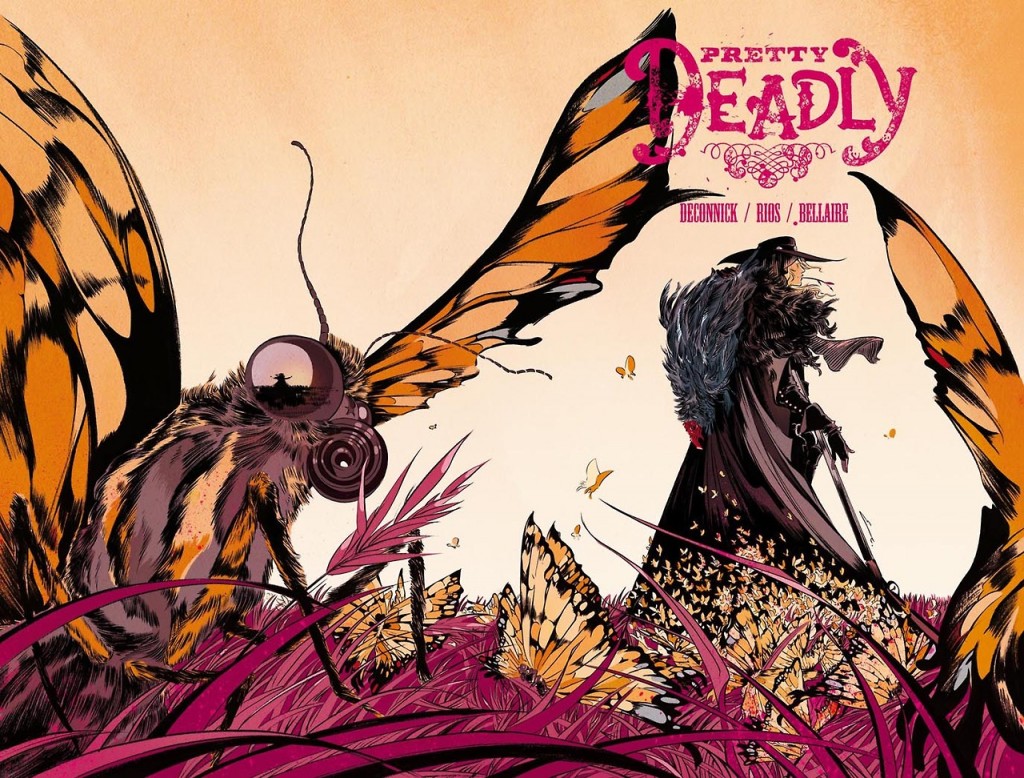
PRETTY DEADLY
Writer: Kelly Sue DeConnick | Artists: Emma Rios, Jordie Bellaire | (Image)
Pretty Deadly arrived in late 2013, but it wasn’t until the series’ first arc was collected that I was able to immerse myself into the world these three top tier creators have built. Set in the old West, this story is half gritty and violent Western, half mystical folkloric tale about the daughter of Death and the various factions who are either chasing after her or protecting her from evil forces.
Lyrical in its narration and unfurling flashbacks, Pretty Deadly reads like a folk song or a tone poem in the way each word and phrase carries both plot and deeper philosophy simultaneously. And Rios’ gorgeously-rendered, sketchy illustration style and Jordie Bellaire’s muted yet lavish colors make this book’s ornate and impressionist artwork sing. It’s unclear where this story is ultimately heading. So far, it’s been a captivating journey; one that allows you to ruminate on something new upon each read.
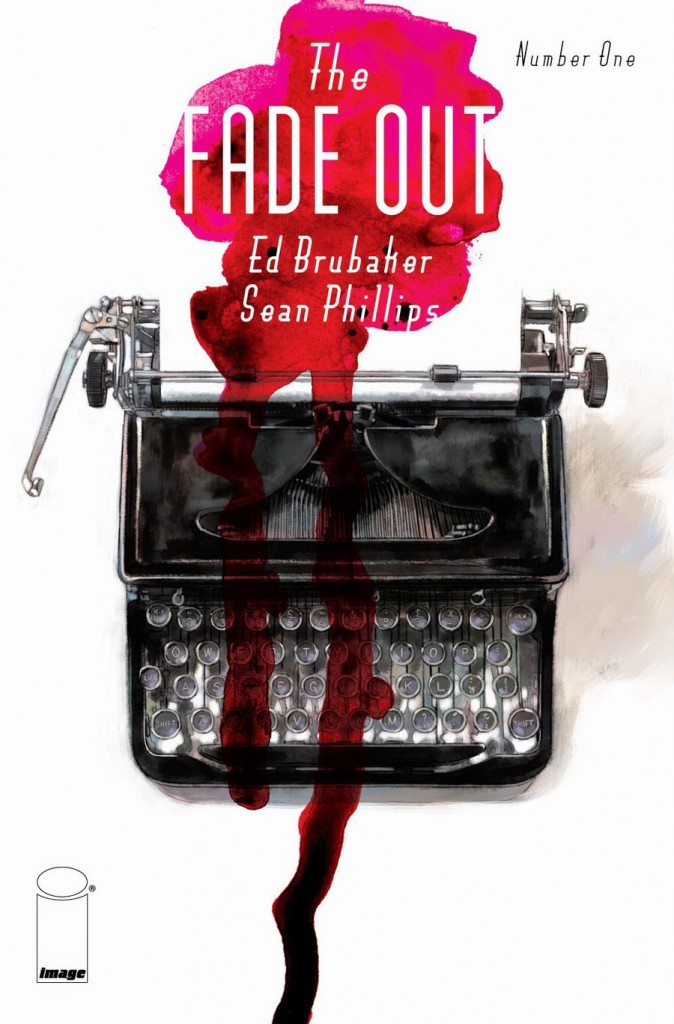
THE FADE OUT
Writer: Ed Brubaker | Artists: Sean Phillips, Bettie Breitweiser | (Image)
It’s safe to say we’re in the midst of a creative boom in comics. That’s especially true for creator-owned material, where most of my favorite mainstream writers from Marvel and DC launched new original series to go along with their superhero work. And some — like Matt Fraction — left it all behind, taking the plunge to go full-on with original material. And then there’s Ed Brubaker and Sean Phillips, the long-running creative duo behind Criminal and much more, who signed a somewhat unprecedented five-year creator-friendly development deal with Image — much in the way a screenwriter may align with a particular studio in Hollywood.
For years, Brubaker and Phillips (and now, colorist Bettie Breitweiser) have honed a brand of pulpy crime fiction, infused with elements of genre fiction like science fiction and superheroes in Incognito, or horror noir in the recently-completed epic Fatale. But throughout, the their distinctive voices and style connect all their work together: it’s moody and sorrowful, scary and unsettling.
The team’s latest book, The Fade Out, is another noir tale, this time set in old Hollywood and the movie industry of the 1940s. Compared to Fatale‘s decades-spanning mythology, or his crackling espionage book Velvet, The Fade Out, on the surface, seems more concisely straight-forward in scope: What appears to be a simple a murder mystery — an actress dies, there’s a coverup, and people try to unearth who’s behind it — quickly reveals something more complex the more you scratch at the edges. And like all of Brubaker’s books, this story is packed with despicably flawed yet relatable characters doing terrible things, keeping secrets and unraveling, with plenty of surprising developments along the way. It’s another fine showing from a creative team perfectly in-sync.

SILVER SURFER
Writer: Dan Slott | Artists: Mike Allred, Laura Allred | (Marvel)
I can’t say I know much about — or ever particularly cared about — the Silver Surfer. I sorta know the basics: He worked for Galactus, that giant purple and pink world-eating cosmic being that was frequently defeated by the Fantastic Four in those early Stan Lee and Jack Kirby comics of the 1960s. Those stories are pure pop art, exploding with crazy ideas and introducing weirdo characters — such as the Inhumans, Black Panther, and basically, the entire Marvel Universe — practically every issue. But Silver Surfer, who is literally silver, and literally travels through space on a #surfbort, came off as a mopey existential ponderer, a reluctant hero, and just plain silly.
But don’t worry. You actually don’t need to know about any of that to enjoy this comic.
In the hands of writer Dan Slott — who’s put in some, um, amazing work with Spider-man for years and years — and the exuberant pop art of Mike and Laura Allred, Silver Surfer has become a joyful must-read book. This book just crackles thanks to wild space locales, bizarre alien creatures and jokes galore. But the most impressive part of this book is not Surfer at all, but the new character Dawn Greenwood, a young woman who’s not only from Earth, but who has never left her sleepy hometown to explore the world. After saving her from a zany kidnapping plot, Dawn and Surfer decide explore the far-reaches of the universe — together. There’s an earnest, wide-eyed and gee-whiz quality in this pairing: Silver Surfer has seemingly seen it all — even the wackiest and most colorful sights in the galaxy. Yet through Dawn’s eyes, he begins to see things anew. As packed with incredible detail as Allred’s art always is, it’s his quiet character moments that allows us to fall in love with these two. Part love story, part cosmic space adventure, this is just plain fun.

SECONDS
Writer/Artist: Bryan Lee O’Malley | (Ballantine)
Most know Bryan Lee O’Malley from his acclaimed and inventive bestselling Scott Pilgrim graphic novel series — or at very least the 2010 Edgar Wright-directed film based on those books, Scott Pilgrim Vs. The World. O’Malley gets a lot of praise for all of his meta-textual layering of video games and anime references and the countless in-jokes about indie rock and action movie tropes. And rightfully so. Yet ultimately, underneath those fun and geeky genre touchstones, those Scott Pilgrim books tell a coming of age story.
Now, after those six installations, and a four-year gap, O’Malley is back. Seconds is a comedic fairy tale, where the protagonist Katie is at a crossroads between her old life and her new one, full of stress and failed relationships. When a magical girl mysterious appears, Katie finds out that she can change a single variable in her past by ingesting a mushroom, writing down her regret and waking up anew in a new alternate reality. As you might expect, things get out of hand very quickly as Katie becomes obsessed with trying to perfect the flaws in her life and reckless behavior, like Sliding Doors-meets-Groundhog Day. Ultimately, this is a story that mulls over themes of accepting responsibility as we get older, being willing to try new things, and how the consequences of choices made in our 20’s eventually catch up with us. Crisply drawn with inventive storytelling layouts, O’Malley has crafted a hilarious and moving story. Seconds is his most mature and stirring work yet.
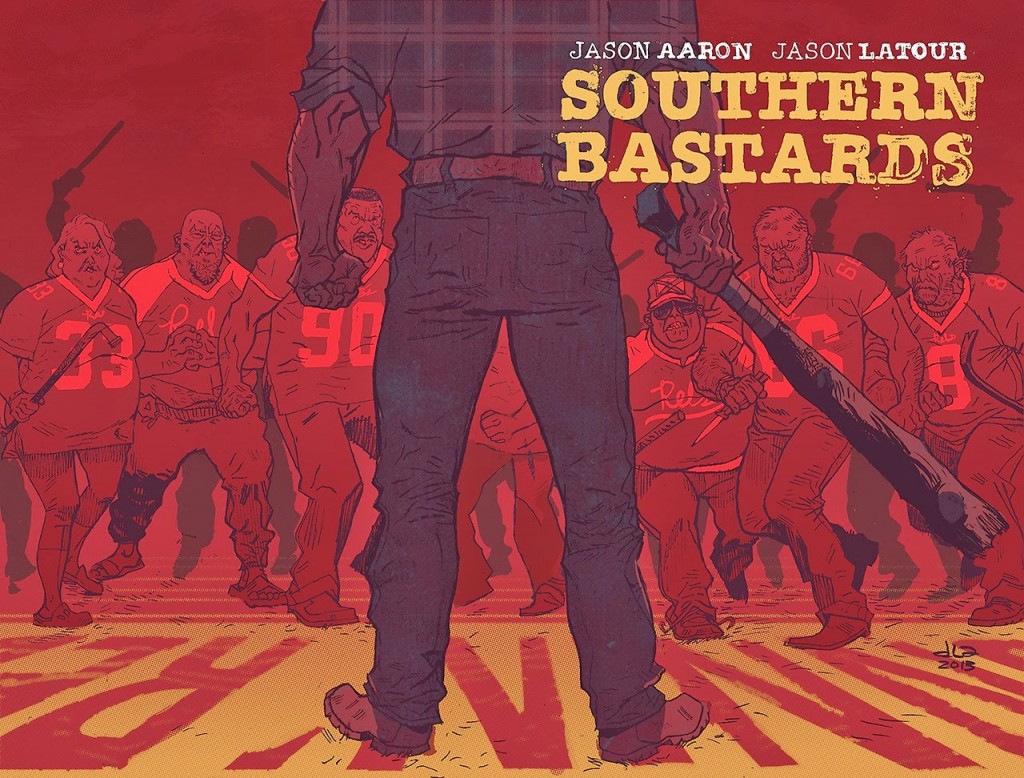
SOUTHERN BASTARDS
Writer: Jason Aaron | Artist: Jason Latour | (Image)
Jason Aaron has continued to churn out excellent work at Marvel — including his refreshingly funny and heartfelt run on Wolverine and the X-Men and his ongoing Thor epic (see below). But for those looking for that same gritty side seen in his long-running Vertigo series Scalped, fans finally got it with his latest creator-owned series, Southern Bastards. Anyone who’s familiar at all with the bushily-bearded writer or illustrator Jason Latour, knows they’re both proud, if conflicted Southerners who have left that world behind, but still have the region in their bloodstream. That theme of identifying with, but also critiquing the place you’re from — especially a place that has some serious historical baggage to contend with — is the primary backbone of this book. It’s crammed with so many cultural references — be it the speech patterns or the clothing or the way of life — that enliven each page with knowing detail.
The story opens with Earl Tubb, a tragic and angry, yet noble old man who finally returns to his hometown many decades after he left. He quickly finds that, in some ways, all the places and characters are exactly the same, preserved in gravelly amber: the old haunts and the BBQ joints, the childhood acquaintances who never managed to leave. But the longer one stays gone, the more jarringly different and fucked up things look with the eyes of an outsider. And like many small towns in the South, football is king. In this case, literally, as the local high school football team is run by Coach Boss, the grizzled and corrupted kingpin who rules the area with a clenched fist and his football team as henchmen. When Tubb finds himself stuck in the middle of a conflict, he decides to clean up the town, one meathead redneck at a time.
The first volume culminates with such a surprising and disturbing paradigm shift that leaves you unsure who’s left to root for — if that’s even an option at all anymore — and what’s to come. It’s a brutal and messy and violent story capturing a true sense of place, that will have you coming back for seconds.

BLACK SCIENCE
Writer: Rick Remender | Artists: Matteo Scalera, Dean White | (Image)
Image has been on a roll lately with new science fiction series — from Jonathan Hickman’s East Of West to Rick Remender’s just released Low. But Black Science is the one I’ve gravitated to the most, even if I can’t say that I totally understand what’s happening. I know it involves leaping from reality to alternate reality, from one universe and world to the next. I know it involves an unlikable ragtag crew of bleeding edge scientists with few morals beyond their own anarchic pursuits, and a pair of bratty kids. I know there’s a bunch of weird creatures and monsters, tribal frog men and some Germans. And I know that every issue does something totally unexpected — like kill of a major character you think you’re rooting for all along.
But that’s the joy of this book. You don’t know really what’s happening, but neither do the characters. And once you get even remotely acclimated, they suddenly jump Quantum Leap-style (or, um Sliders) into another world and another status quo. But regardless, this book rewards repeat reading, both in terms of decoding the plot and searching for breadcrumbs, but also so you can pore over the inky and expressive illustrations of Matteo Scalera and Dean White’s lush colors. Black Science the kind of book you want to spend time with as the unpredictable story quickly speeds along.
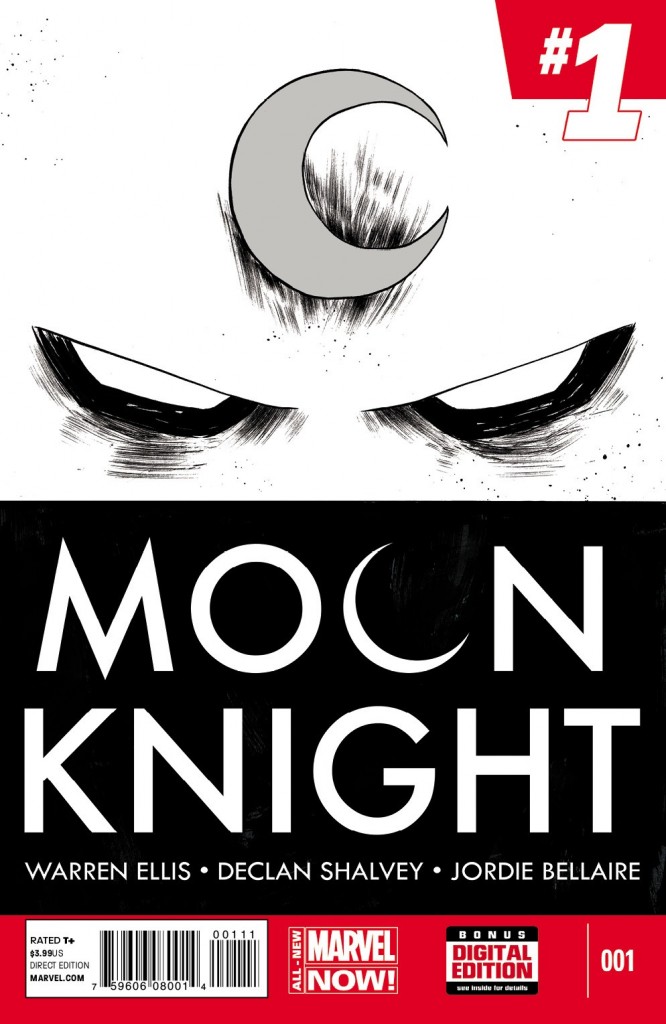
MOON KNIGHT
Writer: Warren Ellis | Artists: Declan Shalvey, Jordie Bellaire | (Marvel)
I like the years-in-the-making, long-gestating story arcs as much as anyone. But sometimes, there’s nothing better than a clean done-in-one story; the type of story told economically, with a beginning and an ending, all in one single issue. While that episodic-style approach is increasingly rare in comics — hell, even TV has gone mostly serialized — it’s something writer Warren Ellis excels at in his brief, yet revelatory six-issue run on Moon Knight.
Moon Knight, as a character, is a tricky nut to crack. Basically, he’s a Batman ripoff dressed in all white (he says he wants criminals to see him coming). He’s a gritty and paranoid antihero that looms in the night, beating the shit out of street criminals. And he’s insane. Like, multiple personalities insane. And there’s some weird mystic stuff going on that may or may not give him his powers — and possibly those wild personality shifts. Many a writer has tried and failed to get a good take on this guy, most recently Brian Michael Bendis and Alex Maleev — who did wonders on Daredevil.
It’s not like Warren Ellis ignores these aspects of the character, but he somehow carves away to the center, grounding him in an almost exasperated creepy calm. Moon Knight, now dressed primarily in a dapper suit and mask (cleverly uncolored as all white, amid colorful, if muted backgrounds), essentially is called in by the New York detectives to investigate murders and odd mysterious crimes, basically as a consultant. And as such, there’s work-a-day Law & Order procedural vibe, with one case per issue. But within that taut noir conceit, Ellis and the fantastic art team of Declan Shalvey and colorist Jordie Bellaire are able to stretch the boundaries of their self-imposed minimal framework and allow themselves to go a little wacky and psychedelic. It’s the perfect example of how by stripping away at a messy character, you can uncover something far more satisfying underneath.
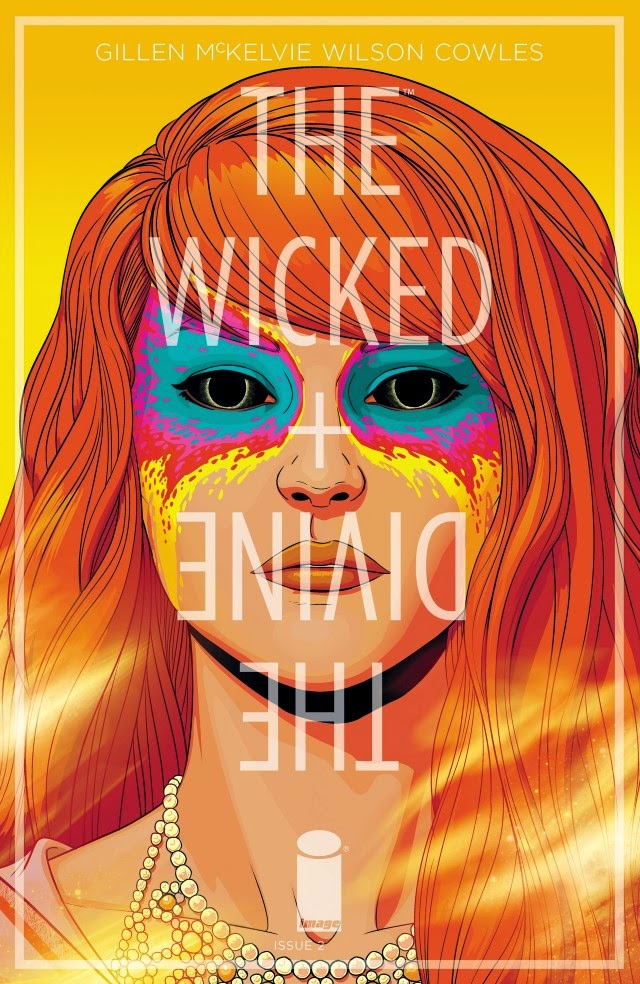
THE WICKED AND THE DIVINE
Writer: Kieron Gillen | Artists: Jamie McKelvie, Matthew Wilson | (Image)
Count me among those fans bummed when Gillen and McKelvie stepped way from their all-too-short run on Young Avengers last year. Despite the superhero trappings, that series that felt completely of the moment in how it felt to be in your early 20s and in transition, trying to figure out who you are. It was inventively constructed both visually and thematically and brimming with pop music from Gillen’s own playlists that informed every character. Thankfully, after both Phonogram and Young Avengers, this collaboration is too exceptional to stop now.
The Wicked And The Divine is the latest original series from the innovative and music-savvy team. And it too delves deep into pop culture and the nature of celebrity with a story equally of-the-moment and utterly fantastical. Here’s the gist: Every 90 years, 12 gods pop up on Earth and become pop stars — and in the age of Beyonce and Lady Gaga and Taylor Swift, pop stars are gods. “They are loved. They are hated. In two years, they are dead.” With a premise as immediately fascinating as that, this series is the perfect comics gateway for music fans with an eye for eloquent design and plenty of pop references.
New Comics I Tried But Need To Spend More Time With:
GUARDIANS OF THE GALAXY (Marvel) | Brian Michael Bendis (writer), Sara Pichelli, et al (art)
Six months ago, a movie starring a ragtag group of criminals, ne’er do wells, and, um, a talking raccoon and his giant tree friend who only says “I am Groot” seemed like a risky gamble. But, thanks to a winning mixture of charmingly offbeat comedy and stunning set pieces, Guardians Of The Galaxy became the biggest movie of the summer, and those unknown characters turned into beloved entries in the Marvel catalogue. I’ve read the first two arcs of Bendis’ current run on the comic, but now, after the movie, I can’t get enough of the characters and their rollicking swagger. I need to make more time for this gang’s ongoing stories.
LOW (Image) | Rick Remender (writer), Greg Tocchini (art)
Where Remender’s Black Science goes all Jack Kirby cosmic and weird, his other sci-fi book, Low, is a complex opera set in a far-off future at the bottom of the ocean, where society seems to be at its crumbling end and their search for an inhabitable planet is running out of time. Even early on, it’s clear this is a book that showcases elegant design and futurist philosophical ponderings.
DEADLY CLASS (Image) | Rick Remender (writer), Wesley Craig (art)
Set in the mid-1980s, a troubled homeless teen is embraced by an ancient society training young people to be highly-skilled assassins and killers. It’s like a dark, morose take on Harry Potter’s Hogwarts or X-Men’s Xavier academy, but this story shows some promise.
THOR (Marvel) | Jason Aaron (writer), Russell Dauterman (art)
Jason Aaron has been crafting an epic Thor run for a few years now, but this latest relaunch finds the Odinson deemed “unworthy” and de-powered. In his place, a mysterious woman who is able to lift the hammer and take on the mantle. While the new direction got a lot of mainstream attention — and some vicious, unconscionable hate from others — under Aaron’s guidance, this Thor story opens up all sorts of new exciting possibilities.
BUCKY BARNES: THE WINTER SOLDIER (Marvel) | Ales Kot (writer), Marco Rudy (art)
When Ed Brubaker brought back Bucky as the Winter Soldier during his phenomenal Captain America run, surely no one at the time knew that character would one day be the star of one of the biggest blockbusters. The Winter Soldier has always been framed as a WWII and Cold War soldier haunted by his dark past, but ultimately that made him a one-note character. Instead, Ales Kot and Marco Rudy push him in new direction: a deep space mission that positions Bucky (along with former S.H.I.E.L.D. agent Daisy Johnson) as the first defense against alien threats to Earth. While it embraces the sullen assassin tone, the cosmic landscapes he visits lets Kot and Rudy have a heyday: With brain-melting psychedelic colors and wild format-breaking storytelling, this high concept book is a visual feast.
Three New Things From 2014 To Still Try:
1. BITCH PLANET, by Kelly Sue DeConnick and Valentine De Landro (Image)
2. WYTCHES, by Scott Snyder and Jock (Image)
3. HERE, by Richard McGuire (Pantheon)
Yep, Still Great:
MIND MGMT (Dark Horse) | Matt Kindt (writer, artist)
The best way to experience Kindt’s knotty story is in big meaty chunks, where you have time to read and reread and dissect the breadcrumb trails and embedded layers of meaning. For a book about mysterious people with various mind-related powers, it makes sense that every mystery answered reveals more questions.
FATALE (Image) | Ed Brubaker (writer), Sean Phillips (art)
The horror noir series wrapped up its two-years-in-the-making and decades-spanning storyline with a brutal, tragic and emotionally pitch-perfect ending.
SAGA (Image) | Brian K. Vaughan (writer), Fiona Staples (art)
The star-crossed couple and their adorable kid are still on the run from powerful forces warring factions. But the biggest threat yet may be their troubled marriage. Story developing…
DAREDEVIL (Marvel) | Mark Waid (writer), Chris Samnee (art)
The acclaimed team relaunched the character with a move from NYC to SF. But the new status quo has only enlivened their creative chemistry. Superhero storytelling at its delightful best.
HAWKEYE (Marvel) | Matt Fraction (writer), David Aja, Annie Wu (artists)
I have no idea what happened between Matt Fraction and Marvel. Maybe he’s just busy writing Sex Criminals or something. But as his remaining issues continue to languish and kill momentum — seriously how many issues did they actually release in 2014? — Hawkeye‘s and Fraction’s absence has been glaring. While few will remember these frequent delays, the mainstream goodwill this acclaimed book earned has nearly fallen by the wayside. Still, the singular creative vision and comedic DNA of Hawkeye can be felt in nearly every one of Marvels’ solo titles: She-Hulk, Black Widow, Ms. Marvel, Moon Knight, and Secret Avengers, too. With two issues left, hope they stick the landing.
THE PRIVATE EYE (Panel Syndicate) | Brian K. Vaughan (writer), Marcos Martin, Muntsa Vicente (art)
In a year full of news headlines about CIA web spying, private celebrity photos stolen and leaked, and Sony emails getting hacked, this post-Internet world Vaughan and Marcos have created (in their DRM-free, pay-what-you-want web comic) seems as prescient as ever.
AVENGERS / NEW AVENGERS (Marvel) | Jonathan Hickman (writer), many many (artists)
I’ve been following, or at least trying to puzzle out Jonathan Hickman’s epic run since the beginning, and I think I’m just as close to understanding it as the characters are with with solving the looming universe-destroying threats. (Which, is to say, I only barely have it pieced together.) But as he reaches its eventual finale, the tensions and stakes have never been higher.
